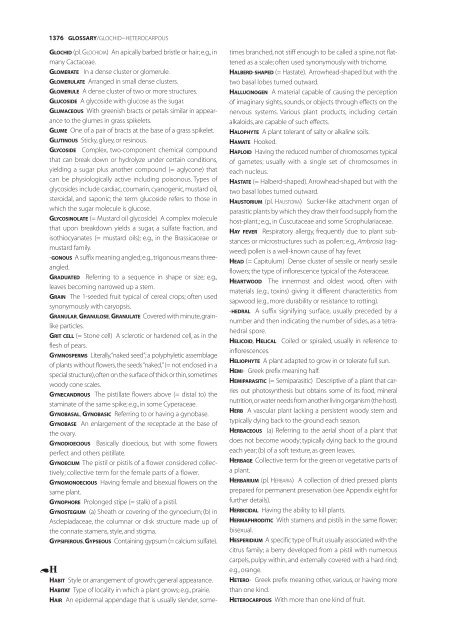Appendices & Glossary - Botanical Research Institute of Texas
Appendices & Glossary - Botanical Research Institute of Texas
Appendices & Glossary - Botanical Research Institute of Texas
Create successful ePaper yourself
Turn your PDF publications into a flip-book with our unique Google optimized e-Paper software.
A<br />
1376 GLOSSARY/GLOCHID–HETEROCARPOUS<br />
GLOCHID (pl. GLOCHIDIA) An apically barbed bristle or hair; e.g., in<br />
many Cactaceae.<br />
GLOMERATE In a dense cluster or glomerule.<br />
GLOMERULATE Arranged in small dense clusters.<br />
GLOMERULE A dense cluster <strong>of</strong> two or more structures.<br />
GLUCOSIDE A glycoside with glucose as the sugar.<br />
GLUMACEOUS With greenish bracts or petals similar in appearance<br />
to the glumes in grass spikelets.<br />
GLUME One <strong>of</strong> a pair <strong>of</strong> bracts at the base <strong>of</strong> a grass spikelet.<br />
GLUTINOUS Sticky, gluey, or resinous.<br />
GLYCOSIDE Complex, two-component chemical compound<br />
that can break down or hydrolyze under certain conditions,<br />
yielding a sugar plus another compound (= aglycone) that<br />
can be physiologically active including poisonous. Types <strong>of</strong><br />
glycosides include cardiac, coumarin, cyanogenic, mustard oil,<br />
steroidal, and saponic; the term glucoside refers to those in<br />
which the sugar molecule is glucose.<br />
GLYCOSINOLATE (= Mustard oil glycoside) A complex molecule<br />
that upon breakdown yields a sugar, a sulfate fraction, and<br />
isothiocyanates (= mustard oils); e.g., in the Brassicaceae or<br />
mustard family.<br />
-GONOUS A suffix meaning angled;e.g.,trigonous means threeangled.<br />
GRADUATED Referring to a sequence in shape or size; e.g.,<br />
leaves becoming narrowed up a stem.<br />
GRAIN The 1-seeded fruit typical <strong>of</strong> cereal crops; <strong>of</strong>ten used<br />
synonymously with caryopsis.<br />
GRANULAR, GRANULOSE, GRANULATE Covered with minute,grainlike<br />
particles.<br />
GRIT CELL (= Stone cell) A sclerotic or hardened cell, as in the<br />
flesh <strong>of</strong> pears.<br />
GYMNOSPERMS Literally,“naked seed”; a polyphyletic assemblage<br />
<strong>of</strong> plants without flowers, the seeds “naked,”(= not enclosed in a<br />
special structure),<strong>of</strong>ten on the surface <strong>of</strong> thick or thin,sometimes<br />
woody cone scales.<br />
GYNECANDROUS The pistillate flowers above (= distal to) the<br />
staminate <strong>of</strong> the same spike; e.g., in some Cyperaceae.<br />
GYNOBASAL, GYNOBASIC Referring to or having a gynobase.<br />
GYNOBASE An enlargement <strong>of</strong> the receptacle at the base <strong>of</strong><br />
the ovary.<br />
GYNODIOECIOUS Basically dioecious, but with some flowers<br />
perfect and others pistillate.<br />
GYNOECIUM The pistil or pistils <strong>of</strong> a flower considered collectively;<br />
collective term for the female parts <strong>of</strong> a flower.<br />
GYNOMONOECIOUS Having female and bisexual flowers on the<br />
same plant.<br />
GYNOPHORE Prolonged stipe (= stalk) <strong>of</strong> a pistil.<br />
GYNOSTEGIUM (a) Sheath or covering <strong>of</strong> the gynoecium; (b) in<br />
Asclepiadaceae, the columnar or disk structure made up <strong>of</strong><br />
the connate stamens, style, and stigma.<br />
GYPSIFEROUS, GYPSEOUS Containing gypsum (= calcium sulfate).<br />
H<br />
HABIT Style or arrangement <strong>of</strong> growth; general appearance.<br />
HABITAT Type <strong>of</strong> locality in which a plant grows; e.g., prairie.<br />
HAIR An epidermal appendage that is usually slender, some-<br />
times branched, not stiff enough to be called a spine, not flattened<br />
as a scale; <strong>of</strong>ten used synonymously with trichome.<br />
HALBERD-SHAPED (= Hastate). Arrowhead-shaped but with the<br />
two basal lobes turned outward.<br />
HALLUCINOGEN A material capable <strong>of</strong> causing the perception<br />
<strong>of</strong> imaginary sights, sounds, or objects through effects on the<br />
nervous systems. Various plant products, including certain<br />
alkaloids, are capable <strong>of</strong> such effects.<br />
HALOPHYTE A plant tolerant <strong>of</strong> salty or alkaline soils.<br />
HAMATE Hooked.<br />
HAPLOID Having the reduced number <strong>of</strong> chromosomes typical<br />
<strong>of</strong> gametes; usually with a single set <strong>of</strong> chromosomes in<br />
each nucleus.<br />
HASTATE (= Halberd-shaped). Arrowhead-shaped but with the<br />
two basal lobes turned outward.<br />
HAUSTORIUM (pl. HAUSTORIA) Sucker-like attachment organ <strong>of</strong><br />
parasitic plants by which they draw their food supply from the<br />
host-plant.; e.g., in Cuscutaceae and some Scrophulariaceae.<br />
HAY FEVER Respiratory allergy, frequently due to plant substances<br />
or microstructures such as pollen; e.g., Ambrosia (ragweed)<br />
pollen is a well-known cause <strong>of</strong> hay fever.<br />
HEAD (= Capitulum) Dense cluster <strong>of</strong> sessile or nearly sessile<br />
flowers; the type <strong>of</strong> inflorescence typical <strong>of</strong> the Asteraceae.<br />
HEARTWOOD The innermost and oldest wood, <strong>of</strong>ten with<br />
materials (e.g., toxins) giving it different characteristics from<br />
sapwood (e.g., more durability or resistance to rotting).<br />
-HEDRAL A suffix signifying surface, usually preceded by a<br />
number and then indicating the number <strong>of</strong> sides, as a tetrahedral<br />
spore.<br />
HELICOID, HELICAL Coiled or spiraled, usually in reference to<br />
inflorescences.<br />
HELIOPHYTE A plant adapted to grow in or tolerate full sun.<br />
HEMI- Greek prefix meaning half.<br />
HEMIPARASITIC (= Semiparasitic) Descriptive <strong>of</strong> a plant that carries<br />
out photosynthesis but obtains some <strong>of</strong> its food, mineral<br />
nutrition,or water needs from another living organism (the host).<br />
HERB A vascular plant lacking a persistent woody stem and<br />
typically dying back to the ground each season.<br />
HERBACEOUS (a) Referring to the aerial shoot <strong>of</strong> a plant that<br />
does not become woody; typically dying back to the ground<br />
each year; (b) <strong>of</strong> a s<strong>of</strong>t texture, as green leaves.<br />
HERBAGE Collective term for the green or vegetative parts <strong>of</strong><br />
a plant.<br />
HERBARIUM (pl. HERBARIA) A collection <strong>of</strong> dried pressed plants<br />
prepared for permanent preservation (see Appendix eight for<br />
further details).<br />
HERBICIDAL Having the ability to kill plants.<br />
HERMAPHRODITIC With stamens and pistils in the same flower;<br />
bisexual.<br />
HESPERIDIUM A specific type <strong>of</strong> fruit usually associated with the<br />
citrus family; a berry developed from a pistil with numerous<br />
carpels, pulpy within, and externally covered with a hard rind;<br />
e.g., orange.<br />
HETERO- Greek prefix meaning other, various, or having more<br />
than one kind.<br />
HETEROCARPOUS With more than one kind <strong>of</strong> fruit.
















